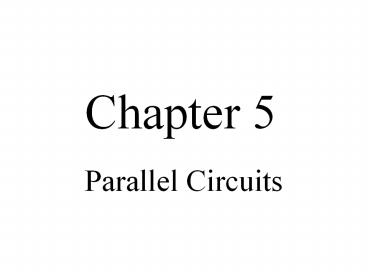Parallel Circuits - PowerPoint PPT Presentation
Title:
Parallel Circuits
Description:
Chapter 5 Parallel Circuits Objectives Identify a parallel circuit Determine the voltage across each parallel branch Apply Kirchhoff s current law Determine total ... – PowerPoint PPT presentation
Number of Views:232
Avg rating:3.0/5.0
Title: Parallel Circuits
1
Chapter 5
- Parallel Circuits
2
Objectives
- Identify a parallel circuit
- Determine the voltage across each parallel branch
- Apply Kirchhoffs current law
- Determine total parallel resistance
- Apply Ohms law in a parallel circuit
- Use a parallel circuit as a current divider
- Determine power in a parallel circuit
3
Resistors in Parallel
- Each current path is called a branch
- A parallel circuit is one that has more than one
branch
4
Identifying Parallel Circuits
- If there is more than one current path (branch)
between two separate points, and if the voltage
between those two points also appears across each
of the branches, then there is a parallel circuit
between those two points
5
Voltage in Parallel Circuits
- The voltage across any given branch of a parallel
circuit is equal to the voltage across each of
the other branches in parallel
6
Kirchhoffs Current Law (KCL)
- The sum of the currents into a node (total
current in) is equal to the sum of the currents
out of that node (total current out) - IIN(1) IIN(2) . . . IIN(n) IOUT(1)
IOUT(2) - . . . IOUT(m)
7
Generalized Circuit Node Illustrating KCL
8
Kirchhoffs Current Law
- Kirchhoffs current Law (KCL) can be stated
another way - The algebraic sum of all the currents entering
and leaving a junction is equal to zero
9
Total Parallel Resistance
- When resistors are connected in parallel, the
total resistance of the circuit decreases - The total resistance of a parallel circuit is
always less than the value of the smallest
resistor
10
Formula for Total Parallel Resistance
- 1/RT 1/R1 1/R2 1/R3 . . . 1/Rn
11
Two Resistors in Parallel
- The total resistance for two resistors in
parallel is equal to the product of the two
resistors divided by the sum of the two resistors - RT R1R2/(R1 R2)
12
Notation for Parallel Resistors
- To indicate 5 resistors, all in parallel, we
would write - R1R2R3R4R5
13
Application of a Parallel Circuit
- One advantage of a parallel circuit over a series
circuit is that when one branch opens, the other
branches are not affected
14
Application of a Parallel Circuit
- All lights and appliances in a home are wired in
parallel - The switches are located in series with the lights
15
Current Dividers
- A parallel circuit acts as a current divider
because the current entering the junction of
parallel branches divides up into several
individual branch currents
16
Current Dividers
- The total current divides among parallel
resistors into currents with values inversely
proportional to the resistance values
17
Current-divider Formulas for Two Branches
- When there are two parallel resistors, the
current-divider formulas for the two branches
are - I1 (R2/(R1 R2))IT
- I2 (R1/(R1 R2))IT
18
General Current-Divider Formula
- The current (Ix) through any branch equals the
total parallel resistance (RT) divided by the
resistance (Rx) of that branch, and then
multiplied by the total current (IT) into the
junction of the parallel branches - Ix (RT/Rx)IT
19
Power in Parallel Circuits
- Total power in a parallel circuit is found by
adding up the powers of all the individual
resistors, the same as for series circuits - PT P1 P2 P3 . . . Pn
20
Open Branches
- When an open circuit occurs in a parallel branch,
the total resistance increases, the total current
decreases, and the same current continues through
each of the remaining parallel paths
21
Open Branches
- When a parallel resistor opens, IT is always less
than its normal value - Once IT and the voltage across the branches are
known, a few calculations will determine the open
resistor when all the resistors are of different
values
22
Summary
- Resistors in parallel are connected across the
same two nodes in a circuit - A parallel circuit provides more than one path
for current - The number of current paths equals the number of
resistors in parallel - The total parallel resistance is less than the
lowest-value parallel resistor
23
Summary
- The voltages across all branches of a parallel
circuit are the same - Kirchhoffs Current Law The sum of the currents
into a node equals the sum of the currents out of
the node - Kirchhoffs Current Law may also be stated as
The algebraic sum of all the currents entering
and leaving a node is zero
24
Summary
- A parallel circuit is a current divider, so
called because the total current entering a node
divides up into each of the branches connected to
the node - If all of the branches of a parallel circuit have
equal resistance, the current through all of the
branches are equal - The total power in a parallel-resistive circuit
is the sum of all the individual powers of the
resistors making up the parallel circuit
25
Summary
- The total power for a parallel circuit can be
calculated with the power formulas using values
of total current, total resistance or total
voltage - If one of the branches of a parallel circuit
opens, the total resistance increases, and
therefore the total current decreases - If a branch of a parallel circuit opens, there is
no change in current through the remaining
branches






























